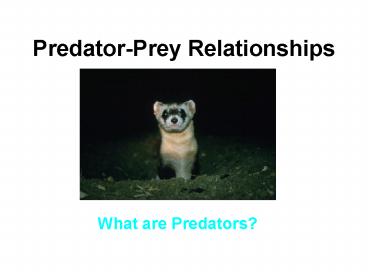PredatorPrey Relationships PowerPoint PPT Presentation
1 / 34
Title: PredatorPrey Relationships
1
Predator-Prey Relationships
- What are Predators?
2
What are predators?
- Carnivory
- Herbivory (plants vs. seeds)
- Cannibalism
- Parasitism
3
Human Attitudes and Predators
- Humans perspectives
- Human persecution
4
OVERCOMING HISTORY
- Fairy Tales Little Red Riding Hood
- The Three Little Pigs
- Wolf attacks on humans
5
OVERCOMING HISTORY
- Old attitudes die hard
- Urban residents and predators
6
Predation in Natural Communities
- Almost all animals have significant predators-
exceptions are - Herbivores Top predators
- Bison Grizzly
- Elephant Lions
- Rhinos Polar bear
- Hippos Killer Whale
7
Predation in Natural Communities
- Do predators regulate prey populations?
- Ecosystems and predator communities
8
Major predators of the Arctic NWR
Wolf
Polar Bear
Grizzly
Ermine
Arctic fox
Snowy Owl
9
Predator-Prey Relationships Response to Prey
- 1. Functional Response
- Tendency of the predator to eat more of a
prey species as the prey become more abundant
10
Predator-Prey Relationships Functional Response
11
Predator-Prey Relationships Response to Prey
- Numerical Response
- Number of predators increases with an
increase in the density of prey animals
12
Predator-Prey RelationshipsNumerical Response
(Buckner and Turnock 1965)
13
Annual cycle of a prey population
100
Energy shortages
Energy shortages
Accidents
Disease
Accidents
Predation
Percentage of Population
Disease
Predation
J F M A M J J A S
O N D
14
Population Cycles
Snowshoe hare
Lynx
No. in thousands
Years
15
Muskrat and Mink
- Paul Erringtons Classic study of muskrat
populations
16
Muskrat info
Habitat wetlands, especially marshes Food
marsh vegetation Predators mink, coyotes, great
horned owls eagles
17
Muskrat and predation
- Observations
- Predation and population size
- Predation and individual vulnerability
18
Muskrat Behavior
- Population size and social intolerance
- Population size and social outcasts
19
Muskrat and Mink interactionsConclusions
- Social interactions may be more important than
predation in limiting numbers of prey. - The total effect of predation cannot be assessed
simply by counting the number of animals killed
by predators (selectivity)
20
Isle Royale
- Size 45 miles long x 9 miles wide
- Protection National Park established in 1940
- Wilderness designation in 1976
- National Biosphere Reserve 1980
- A location of a long term study of the
relationships between the moose and gray wolf
21
Historically, two large ungulates occupied Isle
Royale Woodland Caribou Moose
22
Caribou Population
- Settlers arrived in late 19th century
- Hunted caribou
- Responsible for fire, and forest cutting
- Fires resulted in changing old-growth coniferous
forests to younger deciduous forests - Caribou became extinct on the island
23
Moose History
- Fires resulted in changing old-growth forests to
younger forests - Around 1910, moose came across the ice from
Minnesota and became established - Moose outcompeted woodland caribou island was
better habitat for the moose after fires (early
succession, deciduous trees)
24
Wolfe Population
- Winter 1949, gray wolf arrives by crossing ice
from mainland
25
Current Populations on Isle Royale
Winter 2000-2001 Moose 850 Wolf 29
26
Present Wolf Population on Isle Royale
The wolf population is now divided into 2
territories, rather than the 3 that have been
present for some time West Pack gone Middle
Pack 12 East Pack 10 Roaming animals 5-7
27
Food Chain
Wolf Moose Small rodents
Beaver Grouse
berries Vegetation
28
Wolf Response to Moose
- Functional Response lots of moose,
- Possible because wolfs are cooperative hunters
29
Wolf Response to Moose
- Numerical Response lots of moose,
- wolves reproduce well
- Immigration is unlikely since it depends on Lake
Superior freezing.
30
Moose Response to the Wolf
- Wary formidable prey
- Moose in good condition can withstand an attack
by a wolf pack. - Cant turn and run wolf can sever back leg
tendon which renders the moose helpless.
31
Moose Response to the Wolf
- most vulnerable moose are the very young and the
old (infirm) - most killed moose show signs of malnutrition and
disease (i.e. they are more vulnerable) - Males most vulnerable go into winter in
relatively poor shape because of rut
32
Wolf Population
Three major factors that control the wolf
population 1. Moose numbers 2. Linear
dominance hierarchy in wolf population 3.
Genetic diversity (inbreeding effects)
33
For more Information
www.admin.intu.edu/urel/PressRelease/feature/wolv
es/wolf. Html www.timberwolfinformation.org/progr
ams/awp/awpi/Isle.htm http//midwest.fws.gov/wolf
/proposal/nr_71100.htm
Or simply type in key words wolf, timber
wolf, or Isle Royale
34
How Does The Prey Fight Back

